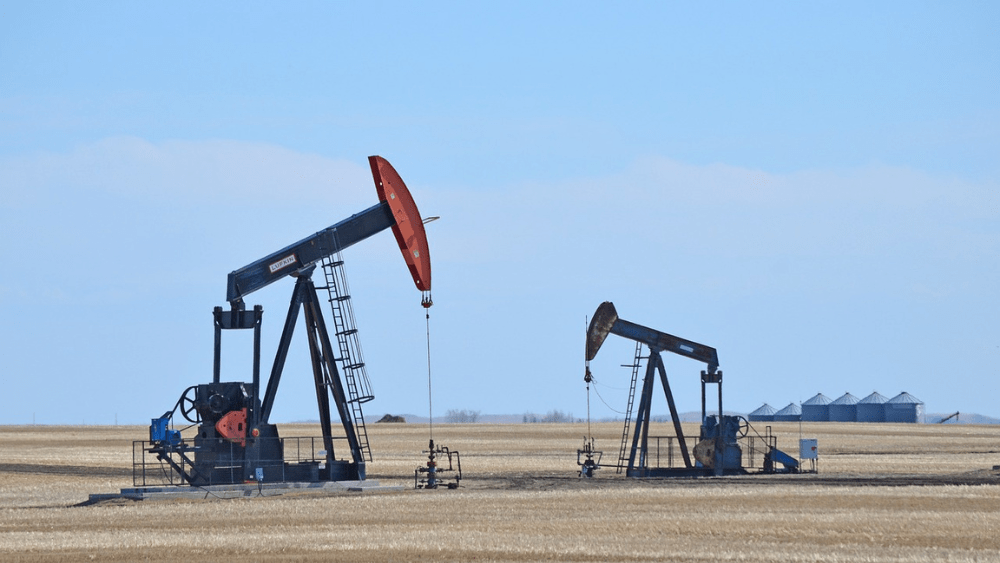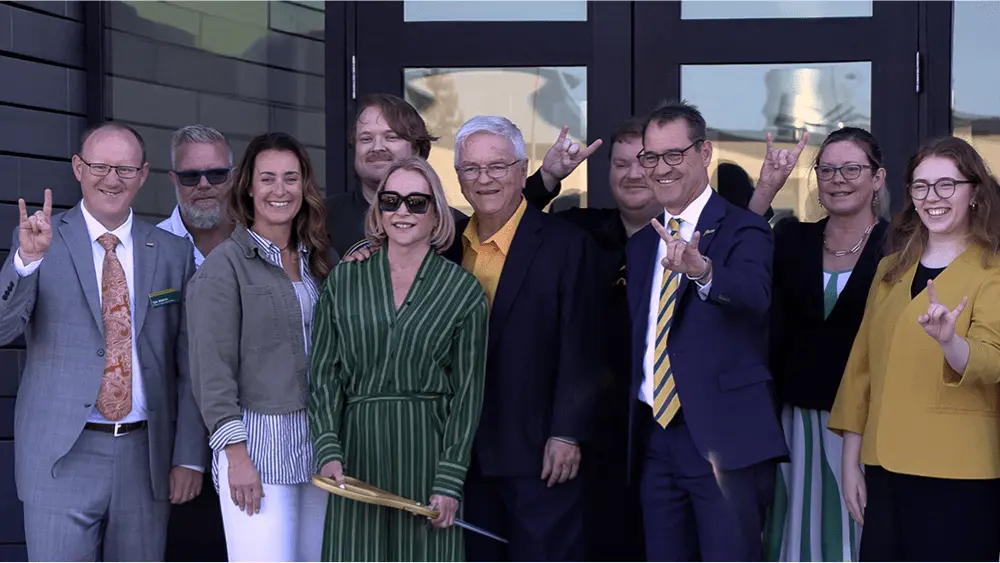NORTH DAKOTA – Lynn Helms is enjoying the first few months of retirement after serving 26 years as the chair of the North Dakota Department of Mineral Resources.
He began his term in 1998, and played a crucial role as the state went from under 100,000 barrels per day to more than 1 million. Recent production numbers from the state’s industrial commission peg the current production at just under 1.2 million barrels per day.
Recently, Helms looked ahead to what a second Trump administration could bring to the country’s energy supply in a radio visit with Scott Hennen on The Flag – WZFG Radio. He began by talking about how the state and the nation blew away many expectations as the industry became more efficient and sophisticated.
“We saw one urban myth, after another, fall. I remember how oil production in the U.S.
had supposedly peaked in the seventies with the opening of Prudhoe Bay (Alaska) and that we would never see that level again. But what they didn’t realize was that our level of understanding of the geology in North America and how to extract hydrocarbons would just grow and grow and grow. So now we’ve surpassed that peak and we’re looking at a plateau well above peak oil from 1979. So that’s just one urban myth that we knocked down. And it goes on and on. When I think about the shale boom and what North Dakotans did to make that happen and then exported it to Wyoming and Colorado and New Mexico and Texas, it literally changed the world,” Helms said.
Wyoming oil production has been a key story in the nation’s energy supply. The state, in 2023, produced 96.8 million barrels of crude oil in 2023, up from 90.8 million in 2022. According to state production figures, Wyoming has about 2% of the country’s proven crude oil reserves, and about 10,600 wells that produce oil. Helms says states around the country have benefitted from research efforts conducted in North Dakota.
“I think of the people that were involved in those early Bakken years, you know, the folks with Brigham Oil and Whiting Oil and Continental Resources that dug into those rocks
and just completely changed our understanding of the geology. And along with that came technology. I’m still astounded by what has happened. I remember working in the industry when it took us three months to drill a 13,000-foot vertical. Now they’re drilling wells that are 10,000 feet deep with a 15,000-foot lateral on them in 12 days. And the changes in the drilling rigs; they’re so much safer. They’re so much faster, they’re so much bigger. And along with that have come incredible environmental benefits. So, there’s so much to talk about, but really it all centered around the great people that put their money and their capital down and said we’re going to try some of these things. We’re going to be innovative. We’re going to invent new ways of producing oil and gas. And by golly, they sure did,” Helms explained.
Hydraulic fracturing, commonly known as fracking, has long been contentious in discussions between energy leaders and fossil fuel opponents. Fracking is a method used to extract oil and natural gas from deep underground rock formations. The process has been used in the United States since 1947. The Independent Petroleum Association of America reports that more than 1.7 million U.S. wells have been completed using the fracking process, producing more than seven billion barrels of oil and 600 trillion cubic feet of natural gas. The process starts when a well is drilled horizontally or vertically. Steel pipes called casings are inserted into the well and the space between the rock and the casing is filled with cement. Then, a mixture of water, sand, and chemicals is pumped into the well at high pressure, causing the rock to crack and release oil or natural gas. Helms chuckles as he looks back on how ideas like fracking were feared by some and targeted by others.
“I’m old enough to recall when I was in grade school, and we were going to go into another glacial age and North Dakota and South Dakota would become uninhabitable. That changed into global warming where it was going to become a desert and uninhabitable. And now, of course, it lives on much weaker as climate change. But I think that, too, is going to be proven wrong. Time after time after time, those projections have proven absolutely false. And it’s all because of the innovators and the people with great hearts. I mean, when you think about the pioneers and the railroad builders that came to North Dakota in the late 19th and early 20th century, they had heart and they had dreams. And they were wanting to prosper and see their future generations prosper. And the way they did that was to risk their lives and their capital homesteading, or building railroads or building small towns and farming in North Dakota. And oil and gas industries are no different. You have entrepreneurs like Harold Hamm that were willing to risk their own personal fortune to see if they could produce oil and gas in North Dakota,” Helms said.
Hamm’s company, Continental Resources, has about 3,500 wells in North Dakota. According to company data, it is the largest leaseholder and the largest producer in the Bakken play of North Dakota and Montana.
“And people like Harold,” continues Helms, “changed the trajectory of North Dakota. You know, when I moved to North Dakota in 1980, it was all about scarcity and population decrease, and population getting older. And the concern was what was going to happen to all the small towns. And the trajectory now is growing population, younger
population, and the abundance of revenue like no one would’ve ever dreamed of.”
Helms says one of the largest threats to the future of the Bakken is regulation, and the increasing bureaucracy that slows industry progress and, in some cases, threatens to
shut it down.
“One thing that I really noticed over the years is how terrible the federal government has been in terms of the changes and the tightening of regulation, year after year after year, making it harder and harder to succeed in the United States, especially in the energy industry. I’ve often thought that if somehow the federal government could follow the North Dakota model, we would have unbelievable success. We would have the resources to pay off our federal debt. I’ve thought this idea of (federal) full-time lifetime legislative work makes no sense. You know, the North Dakota legislature is a part-time job. And after they’re done with their 80 days in Bismarck, they have to go home and live with the laws and rules and regulations that they put in place. Maybe our federal legislators ought to do that and spend twice as much time back home living with what they did,” Helms said.
Helms is encouraged that some new momentum seems to be springing up as a new presidential administration gets set to take office in Washington, D.C. He cites a pair of natural gas projects that are moving forward.
“We still have to stay very focused on this natural gas issue, because that is going to be the future of North Dakota’s oil and gas and energy economy. I am so excited about this new proposal for (WBI’s) West to East Pipeline, bringing natural gas in to supplement wind and coal through the coal producing area, and then taking it east. That’s going to help the Bakken and our electric producers. And then seeing the last permit get approved for the Cerilon gas to liquids plant in Trenton is fantastic. I believe that company’s going to do a great job up there. And the local pushback is going to be proven wrong. The worrying about population growth and traffic and all that sort of thing; they’ll be proven wrong. And then we really have to stay very focused on getting Enhanced Oil Recovery to work,” Helms explained
Enhanced Oil Recovery has been a massive topic in the state’s energy discussion. As the known supply of oil becomes depleted over time, such methods hold promise as a way to extend the life of the Bakken. EOR becomes necessary when primary and secondary recovery methods have been exhausted. These techniques include gas injection (carbon dioxide, nitrogen, or natural gas), chemical injection, or thermal recovery (injecting heat or steam to thin the oil and improve flow.) Liberty Resources owns a well, near Tioga, in which such methods were recently used in a trial. In this case, the company partnered with EOR Etc., to reinject gas and water that are byproducts of oil production back into the well, and adding surfactants, or soaps to force more oil out of the rock structure. The company announced at the Williston Basin Petroleum Conference that in its first pilot project, the technique helped Liberty recover an extra 1,300 barrels of oil with just one injection cycle on one well.
“There are some promising results out of the Liberty pilot and there are three more pilots running elsewhere. I was just reading about some new technology that they’re testing in the Permian (Texas) where they pump an EOR fluid in as a liquid. It converts into a gas in the reservoir, and then it’s produced back and recycled back around. So, I really believe the innovators and the entrepreneurs will solve that problem. And rather than going into long-term decline, 10 to 12 years from now, we’ll see oil production hold at 1.2 to 1.4 million barrels a day and continue to benefit future generations just like it has ours,” Helms said.
North Dakota’s legislature meets every two years, and the subject of EOR has been discussed heavily in advance of the session. Some have called for a massive state initiative to fund research in this area. The thinking goes that if billions more barrels of oil could be produced in a state which sees more than 50% of the state’s tax revenue come from fossil fuels, then such an investment would be wise. Helms would applaud a large state-funded research project.
“I believe we need one. The development, in Texas, of horizontal drilling along with hydraulic fracturing involved the Barnett Shale and the folks down in Dallas used a lot of Department of Energy money and research to make that happen. And something like that is what turned the Bakken on for us in the Williston Basin. So, I think that is the kind of project that we need. And I’m excited to hear that one of our larger companies has brought together three of our producers who are interested in pursuing that. But the state is going to have to reinvest some of the petro dollars that it collects in order to move that project forward. I think that’s the kind of incentive that we need to see. Just like the effort that’s gone into the gas pipeline and getting gas to liquids and value-added gas, it’s going to take state investment, state incentives, and a committed operator with good entrepreneurs to make it happen,” Helms said.
State researchers say that North Dakota’s oil assets contain significant untapped resources in the middle layer of the so-called “Three Forks” Formation, which stretches across parts of Williams, Mountrail, McKenzie and Dunn counties. There appears, they say, to be particularly high extraction potential in McKenzie County.
“There have been about 20 wells drilled in this middle Three Forks unit per year for the last six years, but it probably should be double to triple that,” Tim Nesheim, state subsurface geologist said in a recent interview with the Forum News Agency.
State data, quoted in the article, show that a potential 250 million barrels — or 10.5 billion gallons — of oil could be extracted from a layer as shallow as 50 feet lower than a reservoir already being drilled. State Geologist Ted Starns says those numbers are conservative, but in order to produce such volume, another 600 wells would be needed.
“Ted is right. There’s tremendous potential there.” says Helms. “And, you know, that’s one of my proudest achievements; to bring the geological survey and the oil and gas division together in the Department of Mineral resources because those geological survey people are brilliant. We hired incredible people. They work hard and they’re always looking years out into the future as to what the next potential development is. As far as Ted’s frustration, if you will, I kind of get that, but we’re in a time period just coming out of the Biden years where all industry could really focus on was return on investment to shareholders and private owners, and they were very hampered by federal restrictions. And now we’re coming into an administration that’s going to take the handcuffs off. And so, I think we’ll see investment of capital and more interesting growth. But we went through a long time period there where there just wasn’t much incentive for growth,” Helms said.
Energy leaders around the country have pushed the Biden Administration for a more clear and effective energy policy to keep commodity prices low and to give certainty to the industry. Helms says with new leadership there are high hopes for a commonsense approach to fossil fuels.
“I think we’re going to see a shift in focus from the federal government in supporting EOR and then from the Department of the Interior we’re going to see a faster response in terms of lands that are allowed to be leased and increased speed in permitting and taking the handcuffs off in terms of leasing, permitting and drilling a well. We’ve got several hundred wells in North Dakota that could be drilled if it weren’t for the Biden lockdown, and a slowdown on leasing and permitting. So, I see a shift in focus from worrying about methane emission to thinking about how we can use the North Dakota model to do this in a way that protects the environment but still produces the resources. I think we’re going to see a ‘10x’ of acres available for leasing and a pullback on all these new environmental ideas with plan after plan after plan. So, I’m very hopeful that these next 4 years are going to put us back where we ended the last Trump administration. I served on President Trump’s royalty policy committee back then and there were a lot of things that we wanted to do that we didn’t get accomplished in those four years, so I’m optimistic they’ll get done next time around.”





